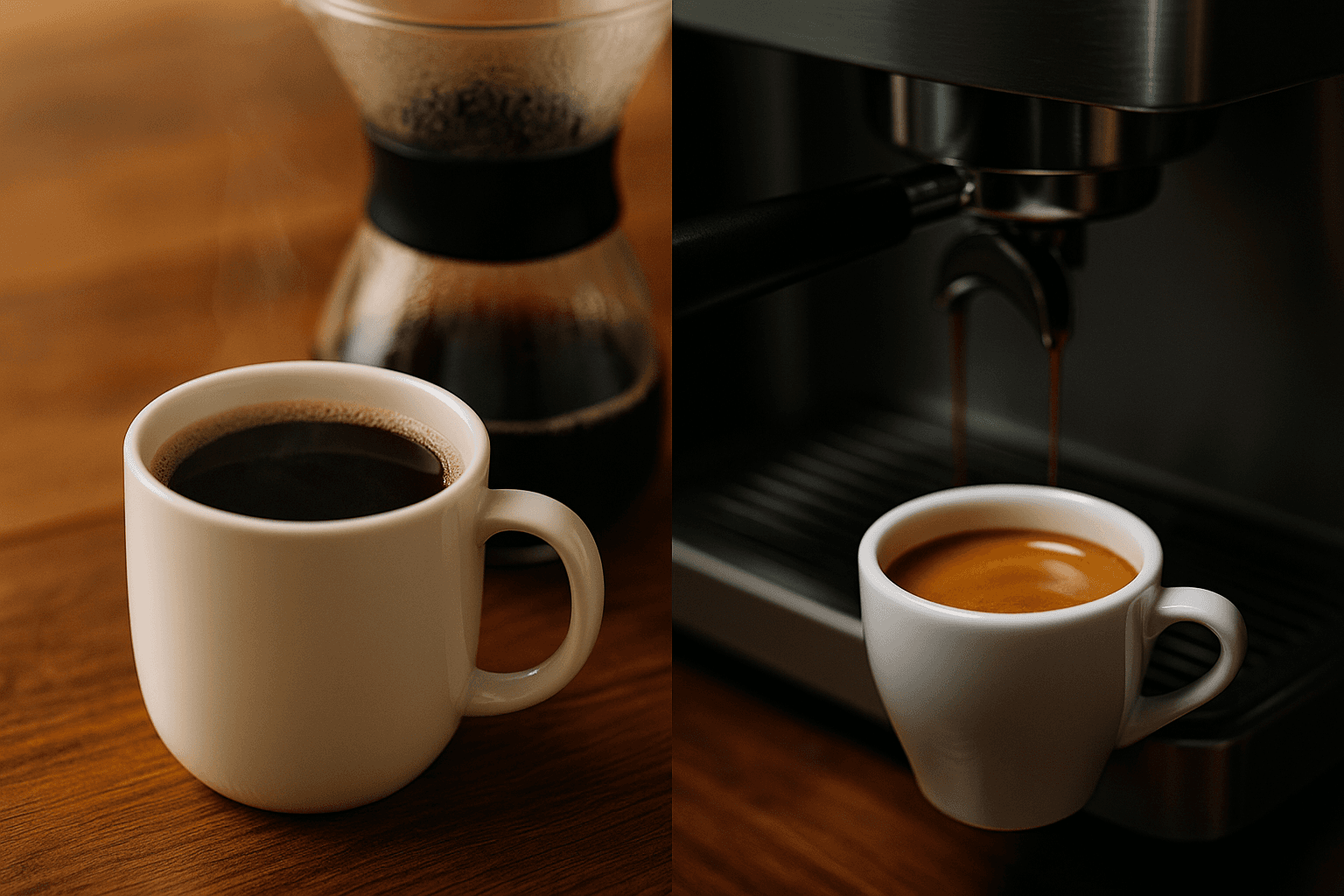While espresso and coffee both originate from the same beans, they are distinctly different in how they’re prepared, served, and consumed. Many cafés list them separately — and for good reason. The difference between espresso and regular coffee is not just in size or strength, but in history, craftsmanship, and culture.
A Shared Origin, Diverging Paths
All espresso is coffee, but not all coffee is espresso. Both are brewed from roasted coffee beans, yet they differ significantly in grind size, brewing technique, caffeine concentration, flavor profile, and serving tradition.
Espresso emerged in early 20th-century Italy, when inventor Luigi Bezzera patented a machine that forced hot water through coffee grounds under high pressure. This innovation shortened brewing time and gave birth to the “espresso” — meaning “pressed out” in Italian. It quickly became a symbol of Italian coffee culture, renowned for its intensity and speed.
Brewing: Pressure Makes the Difference
What truly defines espresso is the pressure applied during brewing. While drip or pour-over coffee is made using gravity, espresso machines use 9 bars of pressure (nine times the atmospheric pressure at sea level) to extract flavors in under 30 seconds. This high-pressure method produces a small but concentrated drink — complete with crema, the golden foam layer that signifies a well-pulled shot.
In contrast, drip or pour-over coffee uses a 1:18 coffee-to-water ratio, resulting in a gentler, longer extraction. Coffee beans are ground coarser than espresso and brewed more slowly, yielding a larger, more diluted cup.
Espresso uses a 1:2 ratio — much stronger — and is brewed with finely ground dark-roasted beans. This produces a dense, bold, and aromatic beverage in just 1 to 2 ounces, typically consumed in a few sips.
Comparing Caffeine and Serving Size
A common misconception is that espresso has more caffeine than regular coffee. While this is true per ounce, the overall caffeine content in a typical 6 to 10 oz cup of drip coffee can surpass that of a single 1 oz espresso shot.
According to Compass Coffee:
-
Drip coffee contains around 12 mg of caffeine per ounce
-
Espresso contains about 63 mg per ounce
Because of this, espresso is ideal for a quick energy boost, but can lead to overconsumption if consumed in large quantities. The FDA recommends no more than 400 mg of caffeine per day, meaning roughly 6 shots of espresso or 3 large cups of coffee.
Flavor Profiles and Experience
Espresso offers intensity. The short, pressurized brew pulls out oils and soluble compounds that drip coffee often leaves behind. Depending on the bean and roast, espresso can have notes of chocolate, spice, roasted nuts, or dried fruit.
Drip or pour-over coffee tends to be lighter and smoother, highlighting floral, fruity, or citrusy undertones. Its slower brew time allows for a more delicate extraction, offering a different kind of complexity.
Usage: Espresso as an Ingredient, Coffee as a Base
Because of its concentrated nature, espresso is often used as a foundation for other drinks:
-
Americano: espresso + hot water
-
Latte: espresso + steamed milk + light foam
-
Cappuccino: espresso + equal parts steamed milk + dense foam
-
Macchiato: espresso + dollop of milk foam
-
Flat white: espresso + velvety microfoam
-
Red eye: coffee + a shot of espresso
-
Affogato: espresso poured over vanilla ice cream
Drip coffee, on the other hand, is typically enjoyed on its own — black or with milk, cream, sugar, or syrups — and is often the go-to choice for cold brew, iced coffee, or batch brewing.
Third-Wave Coffee and the Rise of Precision Brewing
In the modern third-wave coffee movement, espresso and coffee are no longer just drinks — they are expressions of craftsmanship. Baristas and roasters treat coffee like wine: focusing on origin, altitude, processing, and brew parameters to highlight terroir — the “taste of place.”
Single-origin espressos are becoming more common, with precise control over grind size, water temperature, extraction time, and even TDS (Total Dissolved Solids) to create a balanced and personalized experience.
Health, Alternatives, and Decaf Options
For health-conscious drinkers, both espresso and coffee offer significant benefits. Coffee is rich in antioxidants and has been linked to improved cognitive function, metabolism, and heart health — provided it’s consumed in moderation and without excessive sugar or additives.
For those sensitive to caffeine, decaf options are now much more refined. Processes like the Swiss Water Process allow for caffeine removal without compromising flavor. You can now find decaf espresso or decaf pour-over offerings in most specialty cafés.
So Which One Should You Choose?
Here’s a quick guide:
-
Espresso: Best for bold flavor, quick energy, or espresso-based drinks.
-
Drip coffee: Ideal for slow sipping, long conversations, and exploring subtle flavors.
-
Iced variations: Great for hot weather and longer refreshment.
-
Cold brew: Smooth and lower-acid, brewed over hours for a mellow, caffeinated drink.
Final Word
Whether you enjoy the sharp, bold punch of a double espresso or the smooth, aromatic comfort of a pour-over, both drinks reflect the richness and diversity of the coffee world. Understanding their differences helps you not just choose what to drink — but appreciate what goes into each cup.
In the end, it’s not a battle between espresso and coffee. It’s a celebration of both.


